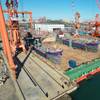Scotland to Power Ferries with Hydrogen
Ferries serving the Western Isles and West Coast of Scotland could soon be powered by hydrogen generated from onshore island wind power, according to a newly published feasibility study.
The Scottish Western Isles Ferry Transport Using Hydrogen (SWIFTH2) project, which was led by the Point and Sandwick Trust in collaboration with seven industry partners including Wood, was part-funded by the Scottish Government’s Low Carbon Infrastructure Transition Programme.
The project team also included Siemens Gamesa Renewable Energy, ITM Power, ENGIE, Ferguson Marine Engineering, Caledonia Marine Assets Ltd and Johnston Carmichael.
The study assessed the feasibility of deploying hydrogen-powered passenger ferries on nine existing Caledonian MacBrayne ferry routes servicing the Western Isles. Various aspects including local available renewable energy resource, planning constraints, challenges associated with the production of hydrogen, and the refuelling requirements of each ferry route were studied.
Of the nine routes analysed, the highest-scoring route using a small ferry on a short crossing was from Barra to Eriskay and the highest scoring route using a large ferry on a long crossing was from Stornoway to Ullapool. The annual hydrogen requirements for the former would be 219 tonnes and for the latter would be 3,676 tonnes.
They found that a single 4.3MW wind turbine generator would be capable of supplying the required hydrogen for the Barra to Eriskay route, while 15 turbines would be required on the Isle of Lewis for the crossing to the mainland.
The potential emissions savings from the replacement of the Barra to Eriskay and Stornoway to Ullapool routes with hydrogen vessels is estimated to be around 676 and 21,815 tonnes of carbon dioxide equivalent per annum respectively, roughly equivalent to taking 147 and 4,742 cars off the road each year.
Whilst the cost of using hydrogen would be more than the current price of marine oil, at between 11p and 17p per kilowatt-hour (kWh) compared to 5p for marine oil, the study found that the price gap is smaller than anticipated.
The project team found that if hydrogen produced from renewable resources for marine transport was to be included in the UK government’s Renewable Transport Fuel Obligation mechanism, that price gap could be narrowed further, with the price of hydrogen falling to between 9p and 12p per kWh.
Steve Noble, vice president of clean energy at Wood, said: “SWIFTH2 is an exciting project which aims to harness the rich renewable energy resources in the West Coast of Scotland for the purposes of generating ‘green’ hydrogen to power future ferry services in the region.
“We are delighted to be involved in a project that will contribute greatly to the Scottish Government’s goal of increasing low emission vessels in the publicly owned ferry fleet by 30% while reducing greenhouse gas emissions.”
Wood’s clean energy team played a key role in the project by coordinating the SWIFTH2 consortium, undertaking the feasibility assessments, and compiling the feasibility study report.
Since the report’s release, the study has featured in the UK Government Department for Transport Clean Maritime Plan 2019. The next phase of the project is to undertake detailed feasibility on two ferry routes and associated islands.














